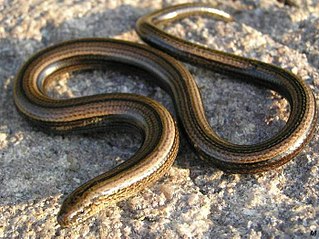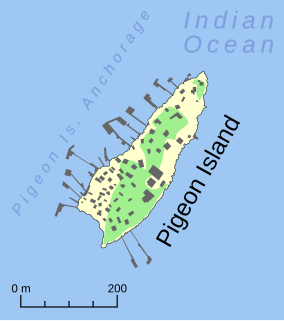
The Houtman Abrolhos is a chain of 122 islands, and associated coral reefs, in the Indian Ocean off the west coast of Australia, about eighty kilometres (50 mi) west of Geraldton, Western Australia. It is the southernmost true coral reef in the Indian Ocean, and one of the highest latitude reef systems in the world. It is one of the world's most important seabird breeding sites, and is the centre of Western Australia's largest single-species fishery, the western rock lobster fishery. It has a small seasonal population of fishermen, and a limited number of tourists are permitted for day trips, but most of the land area is off limits as conservation habitat. It is well known as the site of numerous shipwrecks, the most famous being the Dutch ships Batavia, which was wrecked in 1629, and Zeewijk, wrecked in 1727.

Christinus is a genus of Gekkonidae geckos found in southern regions of Australia. It contains species and subspecies that are regionally termed as marbled geckos. The contrasted patterns of these geckos, marbling, are found in a variety of reddish-brown, grey, silver, white, black and purplish hues. They are frequently found in old knotted trees and sometimes congregate in large numbers in established urban environments.
The mulga dragon is a species of agamid lizard found in Western Australia. The species is up to 250 mm long, the length from snout to vent is 95 mm, with a long, slender tail that ends abruptly. The patterning over the legs and body is grey and brownish streaks. This provides an excellent camouflage on mulga trees, its usual habitat, it is also found beneath mulga leaf litter. Diporiphora amphiboluroides generally remains motionless and unobserved, this allows it to operate as an ambush predator and elude animals that would prey on it.

Ctenotus is a genus of skinks. The genus belongs to a clade in the Sphenomorphus group which contains such genera as Anomalopus and the close relatives Eulamprus and Gnypetoscincus.

Underwoodisaurus milii is a species of gecko, a lizard in the family Carphodactylidae. The species is commonly known as the thick-tailed or barking gecko, referring to its distinctive plump tail and sharp, barking defensive call. The genus is also often called thick-tailed geckos as a group, along with the species Uvidicolus sphyrurus.

Legless lizard may refer to any of several groups of lizards that have independently lost limbs or reduced them to the point of being of no use in locomotion. It is the common name for the family Pygopodidae,. These lizards are often distinguishable from snakes on the basis of one or more of the following characteristics: possessing eyelids, possessing external ear openings, lack of broad belly scales, notched rather than forked tongue, having two more-or-less-equal lungs, and/or having a very long tail.

Pogona minor is a species of agamid lizard from a group commonly known as bearded dragons, and is found on the southwest coast and interior of Western Australia. This taxonomic name includes the widespread type known as western bearded dragon, Pogona minor minor which is widespread across West Australia between the Pilbara and the south coast, and the subspecies, Pogona minor minima is confined to the Wallabi Group of islands. There is another subspecies, Pogona minor mitchelli which lives in tropical woodlands of the Kimberley area of West Australia.

The pygmy python, also known as the anthill python, is a species of snake found in Western Australia. Their common names refer to the fact that they are the smallest member of the family Pythonidae and are often found in termite mounds. The specific epithet is derived from the state capital, Perth, despite the fact that this place is not within the range of the species. No subspecies are currently recognized.
The spotted-thighed tree frog is a Western Australian tree frog species in the family Pelodryadidae.

North Island is the northernmost island in the Houtman Abrolhos, a coral reef archipelago in the Indian Ocean off the coast of Mid West Western Australia. Located about 14 km (9 mi) from the nearest island group, it is one of the largest islands in the Houtman Abrolhos, and one of the few to support dune systems. It has relatively diverse flora dominated by chenopod shrubs and fauna that includes the introduced tammar wallaby, around seven species of reptile, and about 15 resident bird species.

Morelia imbricata is a large snake found in southern regions of Western Australia and western South Australia. A member of the python family, it is commonly known as the southwestern carpet python.

Pogona minor minima, the Abrolhos bearded dragon or Abrolhos dwarf bearded dragon, is an agamid lizard found only on islands at Houtman Abrolhos, and commonly named for this location. It is closely related to other bearded dragons found in Western Australia.

Pigeon Island is a small island located need the middle of the Wallabi Group of the Houtman Abrolhos, an archipelago off the coast of Western Australia. It is almost entirely given over to western rock lobster fishers' camps, and as a result is far more disturbed than most other islands in the archipelago. A nearby island also seasonally populated by fishers is named Little Pigeon Island, hence Pigeon Island is sometimes referred to as "Big Pigeon Island".
Shag Rock is a small rocky island in the Wallabi Group of the Houtman Abrolhos.

Ctenophorus ornatus, the ornate crevice-dragon or ornate dragon, is a species of lizard in the family Agamidae. It is found on granite outcrops of Western Australia.

The western banjo frog is a species of frog from the family Limnodynastidae. The informal names for this species are pobblebonk, sand frog and bullfrog. It is one of the endemic amphibians of Western Australia.

East Wallabi Island is an island in the Wallabi Group of the Houtman Abrolhos, located in the Indian Ocean off the west coast of mainland Australia.
West Wallabi Island is an island in the Wallabi Group of the Houtman Abrolhos, in the Indian Ocean off the west coast of mainland Australia.

Pelsaert Island is one of the islands of the Pelsaert Group, which is the southernmost of the three groups of islands that make up the Houtman Abrolhos island chain in Western Australia.
















